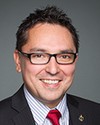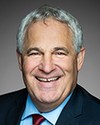I'm proud to say that I started in the gold mines of the Northwest Territories at 17 as a local indigenous hire. Why did they hire me? Well, in the Northwest Territories resource companies were forced to hire local indigenous people as part of their permits. I began a long and healthy career in the mining industry. In my career, which I started as a labourer, I was an underground worker, diamond machine sorter, workforce development coordinator, labour relations specialist, human resources superintendent, corporate responsibility manager, and finally director of corporate responsibility of Cameco Corporation.
At Cameco I was part of a team that led all indigenous community engagement activities in Canada, the United States, and Australia for all uranium projects. This led to innovative approaches to indigenous engagement strategies and plans. It included negotiating five community-based agreements in Canada and Australia and creating a leading-edge indigenous-driven legacy trust fund in northern Saskatchewan earlier this year.
One of the successful community agreements we negotiated and signed was with the Denesuline community of English River First Nation, 600 kilometres north of Saskatoon, for whom I now work through their economic development arm. English River First Nation has had a long history working with the uranium industry in northern Saskatchewan. Like any relationship, it has its ups and downs, but it's always moving forward. What English River saw was an opportunity. The community leaders, the elders, the chief and council, and community members saw that the world wanted and needed the world-class uranium deposits found in their traditional lands. They knew they could support this development and better their communities through the creation of businesses geared to work with the uranium mining companies.
Over the past 25 years, this has evolved into Des Nedhe Development. Just so you know, “Des Nedhe” means “important river” in Dene. That's the Churchill River that runs through northern Saskatchewan.
Des Nedhe is one of the most progressive tier-one aboriginally owned and driven entities in Canada. Des Nedhe is comprised of four distinct business pillars. The first is a retail and property division comprised of a 135-acre urban reserve bordering Saskatoon. This contains a gas station, convenience stores, and commercial property. In addition to this, we have property in Beauval, Saskatchewan. We have a gas station and store there. This borders some of the satellite reserves of English River. We also have a store within the home reserve of Patuanak, northern Saskatchewan.
The second pillar, and really the heart of Des Nedhe, is its industrial division. This includes the first English River company, Tron construction and mining. Tron was really created to do everything for the mining industry. It focused on concrete work, electrical, instrumentation, and construction. It has grown substantially in a good and progressive partnership with the uranium industry in northern Saskatchewan, but it has grown to secure additional work with Saskatchewan's potash mining industry.
In addition to Tron, Des Nedhe built a local consortium comprised of numerous first nations and Métis communities throughout northern Saskatchewan to secure all the development mining for Cameco's mining operations. This partnership has provided strong socio-economic benefits to many of the communities near Cameco's operations. Lastly there's Minetec, a mine supply company that supplies anything that the Saskatchewan mining industry requires, from nuts and bolts to toilet paper.
But to mitigate against the risk of putting all Des Nedhe revenues within the uranium industry, Des Nedhe has pursued a strategy to invest in some of Saskatchewan's blue-chip companies. In 2014 Des Nedhe purchased a majority interest in the already-mentioned Creative Fire, whose 20-year experience in corporate services essentially raises the bar in Canada on what is an aboriginal service firm. With clients such as Federated Co-op, Cameco, Canpotex, the City of Saskatoon, and PotashCorp, Creative Fire offers Des Nedhe a new revenue stream and new employment opportunities for our indigenous owners.
In addition to Creative Fire, in 2015 Des Nedhe, in partnership with Peter Ballantyne Cree Nation, purchased 60% of JNE Welding, a large, well-respected fabrication welding firm in Saskatoon. JNE provides services to a number of large clients who require steel. This includes potash, uranium, oil and gas, and manufacturing industries.
The last business segment of Des Nedhe is the recently created SAGE Power, which is a 100% renewable power company that, when partnered with our other Des Nedhe group of companies, becomes the only indigenous vertically integrated renewable power company in Canada.
Des Nedhe is a leading example we are proud to represent, which highlights what can be achieved when local first nations are engaged and partnerships are created and developed within the mining industry.
One of the questions posed within this standing committee is this: how we can ensure that indigenous peoples and communities are meaningfully engaged through all stages of mineral development and production? In my experience, the great majority of indigenous communities are not against resource development, even though it may be portrayed this way. In my discussions from coast to coast to coast, I see that indigenous people want to be treated as partners, not a regulatory check box. Our communities want to ensure that their views and inputs are incorporated throughout the development of mineral resources, especially when it comes to environmental planning, monitoring, and into decommissioning. The bottom line is that indigenous communities will support mining development, but not at the expense of a poor environmental stewardship plan.
At the core of this discussion is “how”. In my experience, the key is to create community-driven input and build that relationship right from the start. Yes, we need the policy and we need the legal framework, but I would ask you to also remember the young boys and girls out there who just want the opportunity for a job. Sometimes we get stuck in rhetoric around the law and around public policy, which are great long-term objectives, but value to Canadians is created when we hire people in local communities who are currently on social assistance. You hire individuals, you give them an opportunity on a drill rig, or during exploration, or a labour position at a gold or uranium mine, and they start paying taxes into the system. So they turn into a net positive for everybody in this country from a GDP angle.
As mentioned above, environmental stewardship is key, but of most importance is how you engage the community. A robust community engagement plan will flesh out both parties' intents and long-term objectives. In most instances I've seen, companies and communities may even find shared objectives. A good example of this is in northern Canada. When a community and company sit down, you might flesh out how road access is important to company and community, so how do you work together on investments, on P3 ideas, to provide a road that would lower cost of living in the community and also make the deposit more accessible?
These shared objectives will lead to socio-economic benefits that will be shared. These include creating pillars such as workforce development, which essentially means the training, education, and employment of local indigenous people. In Canada the mining industry has been a strong champion in the employment of thousands of indigenous people like me. Many have gone on to strong careers. Not only employment but supportive education, through scholarships and the support of pre-employment training programs, provide opportunities to future generations.
Second is business development, where community and company come together to discuss and plan on how to provide mining service contracting opportunities to local indigenous communities. We have found that investment in local aboriginal business plans is the best way to close the gap on socio-economics, as it not only spurs additional employment but also provides communities with own-source revenues.
Third is community investment. This can take many forms, from straight revenue-sharing via impact benefit agreements to annual budgets where company and community work together to fund community projects like education, culture, elder projects, or youth projects.
Last, we come back to environmental stewardship. As mentioned before, it is key that indigenous input is captured throughout the process—but how? Programs such as joint committees, elders traditional knowledge workshops, and youth engagement sessions are all great tools to ensure that community input is obtained. Leading-edge programs in Canada go so far to provide all the decommissioning work directly to the closest indigenous community as a business opportunity, so that they have a stake both in the opportunity of the clean-up but also to monitor the progress.








